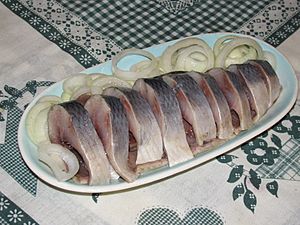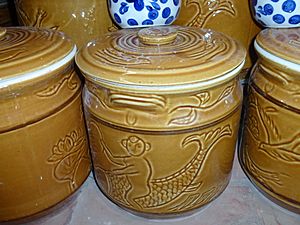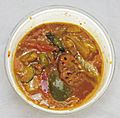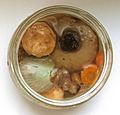Pickling facts for kids

Pickling is a clever way to make food last much longer. When you pickle something, you put it into either vinegar or a special salty water called brine. This process not only helps keep food from spoiling, but it also gives it a totally new and often tangy flavor! Many vegetables are preserved this way.
The main secret to pickling is that it makes the food very acidic. This low acidity (called low pH) stops most tiny germs, like bacteria, from growing. Because of this, pickled foods can stay fresh for many months. Sometimes, people add special herbs and spices like mustard seeds, garlic, cinnamon, or cloves. These spices also help fight off tiny germs and add more flavor.
Contents
How Pickling Works
There are a few ways to pickle food, but they all aim to make the food acidic and safe to eat for a long time.
Traditional Pickling
In traditional pickling, you put fruits or vegetables into a salty water solution (brine). Sometimes, like with sauerkraut, the vegetables are shredded and salted. Then, they are pressed down, often with flat stones, to keep them under the water. This helps a natural process called fermentation begin.
During fermentation, good Lactobacillus bacteria grow. These bacteria create lactic acid, which is a natural preservative. Sometimes, a harmless white yeast might form on the surface. It can be removed without affecting the pickling.
Chemical Pickling
Chemical pickling is a bit different. Here, you place the fruits or vegetables into a clean jar. Then, you pour in a mix of brine, vinegar, or both. Spices are often added too. The food then sits and soaks up these flavors until it tastes just right.
Sometimes, food is soaked in brine first before being moved to vinegar. This helps remove some of the water from the food. This is especially helpful for fruits and vegetables that have a lot of natural water, as it keeps the vinegar from getting too watered down.
Commercial Pickling
When food is pickled in factories, they might add extra things to make it last even longer. These are called preservatives, like sodium benzoate.
Refrigerator Pickles
"Refrigerator pickles" are a quick and easy type of pickle. They are not fermented. Instead, you simply soak fruits or vegetables in a seasoned vinegar mix. These pickles need to be kept in the fridge or sealed in jars (canned) if you want them to last a long time.
Japanese Tsukemono
In Japan, there are many kinds of pickled foods called Tsukemono. They use different pickling ingredients depending on the type. These ingredients are mixed with vegetables and often put under pressure to create unique flavors.
Alum is a special ingredient sometimes used in pickling. It helps make the pickled food stay nice and crisp. The United States Food and Drug Administration says it's safe to use in food.
Images for kids
-
A jar of pickled cucumbers (front) and a jar of pickled onions (back)
-
Dưa cải muối made from cải bẹ xanh
-
Kimchi is a very common side dish in Korea.
-
Torshi, traditional pickles in Southeast Europe, Turkey and the South Caucasus
-
Coriander seeds are one of the spices popularly added to pickled vegetables in Europe.
-
Jonjoli Georgian pickled flowers of bladdernut
-
Pickled tomatoes are common in CIS
-
A dish of giardiniera
-
Pickled mushrooms
-
Pickled olives
See also
 In Spanish: Encurtido para niños
In Spanish: Encurtido para niños

















